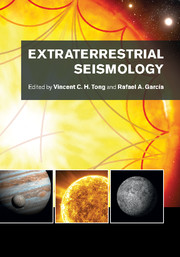Book contents
- Frontmatter
- Contents
- List of contributors
- Preface
- Acknowledgements
- List of abbreviations
- Planetary seismology: High risk, high return
- A bright outlook for helio- and asteroseismology
- Part I Observation and space missions
- Part II Data and physical parameters
- Part III Modeling approaches
- Part IV Discoveries of physical structures and processes
- Part V Interdisciplinary research involving planetary and astrophysical sciences
- Part VI Interdisciplinary research involving terrestrial seismology
- 24 The interpretation of seismic travel times
- 25 Interpreting cross-correlations in seismology
- 26 Waveform tomography in geophysics and helioseismology
- References
- Index
24 - The interpretation of seismic travel times
from Part VI - Interdisciplinary research involving terrestrial seismology
Published online by Cambridge University Press: 05 July 2015
- Frontmatter
- Contents
- List of contributors
- Preface
- Acknowledgements
- List of abbreviations
- Planetary seismology: High risk, high return
- A bright outlook for helio- and asteroseismology
- Part I Observation and space missions
- Part II Data and physical parameters
- Part III Modeling approaches
- Part IV Discoveries of physical structures and processes
- Part V Interdisciplinary research involving planetary and astrophysical sciences
- Part VI Interdisciplinary research involving terrestrial seismology
- 24 The interpretation of seismic travel times
- 25 Interpreting cross-correlations in seismology
- 26 Waveform tomography in geophysics and helioseismology
- References
- Index
Summary
Introduction
For a long time, (geo)physicists have considered the Earth as a spherically symmetric body, compositionally divided into an iron core, a silicate mantle, and a crust mostly built from melts rising to the surface. However, the surface of the Earth, divided into oceans and continents, betrays the existence of lateral differences that cannot be ignored. None of our oceans is older than 200 million years, whereas there are indications that the first continents started to form 4.3 billion years ago. The processes that impose such differences must operate at depth. The fact that heat cannot escape sufficiently fast by conduction, yet the mantle is not molten, leaves no doubt that some kind of convective engine operates to cool the mantle and to drive the observable motions of the much more rigid plates covering the surface (Jaupart and Mareschal, 2010).
To study the dynamic processes in the interior, we can inspect various physical fields for signs of lateral heterogeneity: the gravity field, the magnetic field, the response of the electromagnetic field to forcings in the atmosphere and beyond, and the seismic wavefield after a strong earthquake. We are often interested in anomalies, i.e., in deviations from spherical symmetry. Here we shall concentrate on the seismic field, for the simple reason that it has the most powerful information about variations in elastic properties in the interior that are themselves influenced by temperature variations and – probably to a lesser degree – by chemical differences. The analysis of seismic waves has given us detailed images of wave speed variations in the interior of the Earth and Sun. On Mars, Mercury, or one of the many moons in the Solar System, we shall at best be able to observe the seismic field with a handful of seismometers, and we wish to extract as much information from such seismic recordings as possible. Fortunately, recent developments in terrestrial seismic tomography have led to significant progress in analyzing the observed field.
- Type
- Chapter
- Information
- Extraterrestrial Seismology , pp. 341 - 352Publisher: Cambridge University PressPrint publication year: 2015



